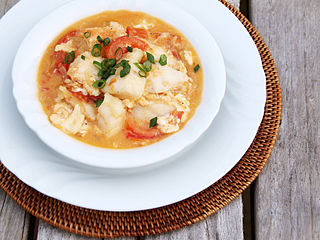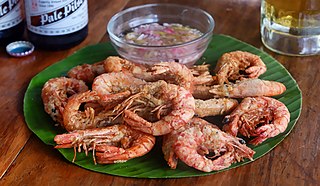Sweet and sour is a generic term that encompasses many styles of sauce, cuisine, and cooking methods. It is commonly used in East Asia and Southeast Asia and has been used in England since the Middle Ages. Sweet and sour sauce remains popular in Asian and Western cuisines.

Chicharrón is a dish generally consisting of fried pork belly or fried pork rinds. Chicharrón may also be made from chicken, mutton, or beef.

Filipino cuisine is composed of the cuisines of more than a hundred distinct ethnolinguistic groups found throughout the Philippine archipelago. A majority of mainstream Filipino dishes that compose Filipino cuisine are from the food traditions of various ethnolinguistic groups and tribes of the archipelago, including the Ilocano, Pangasinan, Kapampangan, Tagalog, Bicolano, Visayan, Chavacano, and Maranao ethnolinguistic groups. The dishes associated with these groups evolved over the centuries from a largely indigenous base shared with maritime Southeast Asia with varied influences from Chinese, Spanish, and American cuisines, in line with the major waves of influence that had enriched the cultures of the archipelago, and adapted using indigenous ingredients to meet local preferences.

Kare-kare is a Philippine stew that features a thick savory peanut sauce. It is generally made from a base of stewed oxtail, beef tripe, pork hocks, calves' feet, pig's feet or trotters, various cuts of pork, beef stew meat, and occasionally offal. Vegetables, such as eggplant, Chinese cabbage, or other greens, daikon, green beans, okra, and asparagus beans, are added. The stew is flavored with ground roasted peanuts or peanut butter, onions, and garlic. It is colored with annatto and can be thickened with toasted or plain ground rice. Variations of kare-kare can be made with seafood, such as prawns, squid, and mussels, or exclusively from vegetables.

Fried noodles are common throughout East Asia, Southeast Asia and South Asia. Many varieties, cooking styles, and ingredients exist.

Fried onions are slices of onions that are either pan fried (sautéed) or deep fried — and consumed as a popular snack food, garnish, or vegetable accompaniment to various recipes.

A banana fritter is a fritter made by deep frying battered banana or plantain in hot cooking oil. It is a common dish across Southeast Asia and South India.

Camaron rebosado is a deep-fried battered shrimp dish in Philippine cuisine. It is usually served with a sweet and sour sauce. It is a common dish in Philippine cuisine.

Bagnet, also locally known as "chicharon" or tsitsaron in Ilocano, is a Filipino dish consisting of pork belly (liempo) boiled and deep fried until it is crispy. It is seasoned with garlic, black peppercorns, bay leaves, and salt. First, the meat is boiled, and, then allowed to thoroughly drain excess moisture overnight before frying, to achieve its characteristic chicharon-like texture. Bagnet can be eaten on its own or with white rice. It can also be used as an ingredient or paired with other dishes like pinakbet and dinardaraan.

Hamonado, or hamonada, is a Filipino dish consisting of meat marinated and cooked in a sweet pineapple sauce. It is a popular dish during Christmas in Philippine regions where pineapples are commonly grown. Hamonado is also a general term for savory dishes marinated or cooked with pineapple in the Philippines.

Sarsiado is a fish dish from the Philippines which features tomatoes and eggs. The name sarsiado in the Tagalog language means "cooked with a thick sauce". The name is derived from the Filipino word sarsa which in turn is from the Spanish word salsa, which means "sauce".

Ifumi is an Indonesian crispy deep fried thick noodle dish, popular in Maritime Southeast Asia, served in a thick savoury sauce with pieces of meat or seafood and vegetables. The dishes are to be served hot while the noodles are still crisp until the noodles are softened by the sauce and are ready to be eaten. The dish is one of the most popular noodle dishes in Chinese Indonesian cuisine. The type of noodle being used in this dish is the thick yi mein noodle, hence the origin of its name. It is quite similar to mie kering noodles from Makassar.

Tortang talong, also known as eggplant omelette, is an omelette or fritter from Filipino cuisine made by pan-frying grilled whole eggplants dipped in an egg mixture. It is a popular breakfast and lunch meal in the Philippines. A common variant of tortang talong is rellenong talong, which is stuffed with meat, seafood, and/or vegetables.

Okoy or ukoy, are Filipino crispy deep-fried fritters made with glutinous rice batter, unshelled small shrimp, and various vegetables, including calabaza, sweet potato, cassava, mung bean sprouts, scallions and julienned carrots, onions, and green papaya. They are traditionally served with vinegar-based dipping sauces. They are eaten on their own or with white rice. They are popular for breakfast, snacks, or appetizers. Okoy are sometimes dyed bright orange with achuete seeds.

Philippine asado refers to two different Filipino braised meat dishes. The name originates from Spanish asado ("grilled"), a reference to the original dish it was applied to, the Chinese-Filipino version of char siu barbecues usually known as pork asado. However, the Filipino versions have evolved to be braised, not grilled. The other Filipino dishes also known as asado are asado de carajay and asado matua. Unlike the Chinese-derived version, they are savory rather than sweet.

Nilasing na hipon is a Filipino dish consisting of whole unshelled shrimp marinated in alcohol and various spices, usually coated in batter, and then deep-fried. It is usually dipped in a vinegar-based sauce. The alcohol used is traditionally rice wine like basi or arrack like lambanog; but modern versions can use other types of alcohol, most commonly gin, beer, or white wine.
















